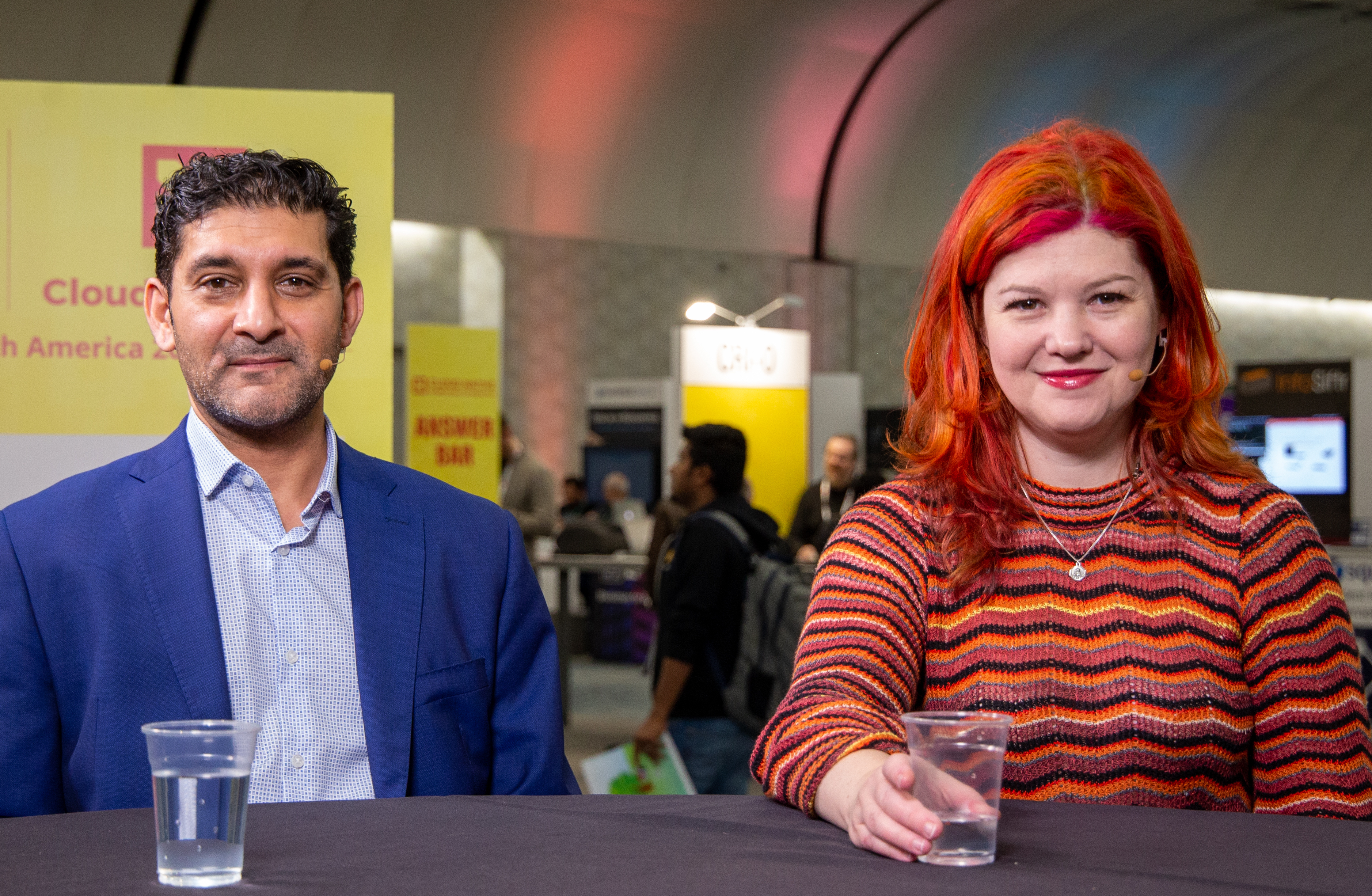 EMERGING TECH
EMERGING TECH
 EMERGING TECH
EMERGING TECH
 EMERGING TECH
EMERGING TECH
Connectivity is essential in the modern world. But like other important infrastructure, the networking that makes communication simple is hidden behind the scenes.
In a recent demonstration of cutting-edge network technology, a group of volunteers from the telecommunications industry created an end-to-end, 5G, cloud-native network live on the stage at the KubeCon + CloudNativeCon event in San Diego, California.
“Networking is amazing. It just happens to be there, sort of like plumbing and power. But to actually deliver it is a fairly complicated challenge,” said Heather Kirksey (pictured, right), vice president of community and ecosystem development at the Linux Foundation.
Kirksey and Sandeep Panesar (pictured, left), senior vice president of strategic engagement at Turnium Technology Group Inc., spoke with Stu Miniman (@stu), host of theCUBE, SiliconANGLE Media’s mobile livestreaming studio, and guest host John Troyer (@jtroyer), chief reckoner at TechReckoning, during the KubeCon + CloudNativeCon event in San Diego, California. They discussed the open-source collaboration between the Linux Foundation networking project and the global networking ecosystem that showcased cloud-native 5G in action. (* Disclosure below.)
[Editor’s note: The following answers have been condensed for clarity.]
Miniman: This was a really cool demo with a lot of things going behind the scenes. Can you give us an idea of how something like this comes together?
Kirksey: We sent out a call to the community and said: “We’re going to try to do full 5G, full cloud native. If you’re interested in joining come on.” 15 organizations said, “Yes, that sounds like something that we would like to prove out.” And 80 volunteers across those organizations ended up working on it.
Miniman: What were some of the issues you encountered?
Kirksey: This was so cutting edge in terms of the 5G aspect that just getting equipment was challenging. And that’s before you even get to building the stack.
Miniman: Turnium Technology is one of the providers that helped with that. Sandeep, can you tell us what drew you into the project and how it is living on that bleeding edge with something like 5G?
Panesar: We’re providing the SD-WAN for this project, connecting the public cloud with the private cloud, deploying and using containers — Kubernetes. We are able to bring the entire thing together by creating one virtual network so that it’s seamless, and all the underlying infrastructure, the layer two, layer one, the underlay is just completely invisible.
It’s absolutely thrilling living on that bleeding edge. It’s exciting, lots of risk, but the pay off yesterday was fantastic — to be able to complete that call while on stage. It really is a community filled with love and a real drive and desire to build something new and different.
Miniman: Tell us more about how SD-WAN fits into the entire 5G multicloud discussion.
Panesar: At the end of the day, you know Kubernetes is a platform or a tool. SD-WAN is a tool. And if you take all of these tools and put them together, you can actually build something wonderful. That’s what we did in this project here. We were able to deliver a 5G call and run it everywhere.
So, I think what’s important is even though this is really primarily a developer event and a developer show, you’re seeing some edge people here; you are seeing some networking people here. And the awareness that we need edge and we need networking to actually build commercializable platforms or products is really starting to come out.
Troyer: This demonstration is a great example of how the Linux Foundation can be a catalyst to bring an industry together. Could you talk about some of the work the Linux Foundation is doing in the telecom world?
Kirksey: Telecom definitely likes to be opinionated — that’s kind of in our soul. But it also is useful because, really at the end of the day, interoperability for the type of scale that telecom operators have is very important. They’re using all these applications to write services to their customers, so they have a business need to make sure everything really works end to end.
So, there’s actually an initiative right now between the LF Networking project and the GSMA [mobile operators industry association]. [We’re looking for] opinion around what should the cloud platforms look like and how can we start doing things like compliance and verification programs around commercial implementations. Whether it is the underlying platform or whether it’s the applications on top. Because at the end of the day, we’re really needing to help them accelerate their deployments and get that agility that’s the promise of cloud.
Watch the complete video interview below, and be sure to check out more of SiliconANGLE’s and theCUBE’s coverage of the KubeCon + CloudNativeCon event. (* Disclosure: The Cloud Native Computing Foundation sponsored this segment of theCUBE. Neither CNCF nor other sponsors have editorial control over content on theCUBE or SiliconANGLE.)
Support our open free content by sharing and engaging with our content and community.
Where Technology Leaders Connect, Share Intelligence & Create Opportunities
SiliconANGLE Media is a recognized leader in digital media innovation serving innovative audiences and brands, bringing together cutting-edge technology, influential content, strategic insights and real-time audience engagement. As the parent company of SiliconANGLE, theCUBE Network, theCUBE Research, CUBE365, theCUBE AI and theCUBE SuperStudios — such as those established in Silicon Valley and the New York Stock Exchange (NYSE) — SiliconANGLE Media operates at the intersection of media, technology, and AI. .
Founded by tech visionaries John Furrier and Dave Vellante, SiliconANGLE Media has built a powerful ecosystem of industry-leading digital media brands, with a reach of 15+ million elite tech professionals. The company’s new, proprietary theCUBE AI Video cloud is breaking ground in audience interaction, leveraging theCUBEai.com neural network to help technology companies make data-driven decisions and stay at the forefront of industry conversations.